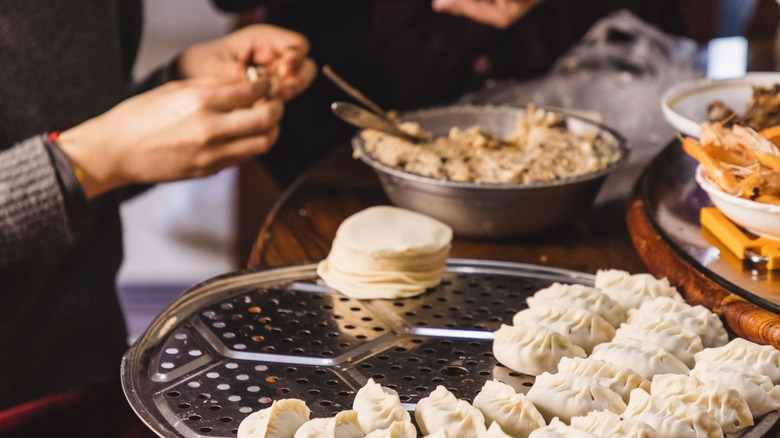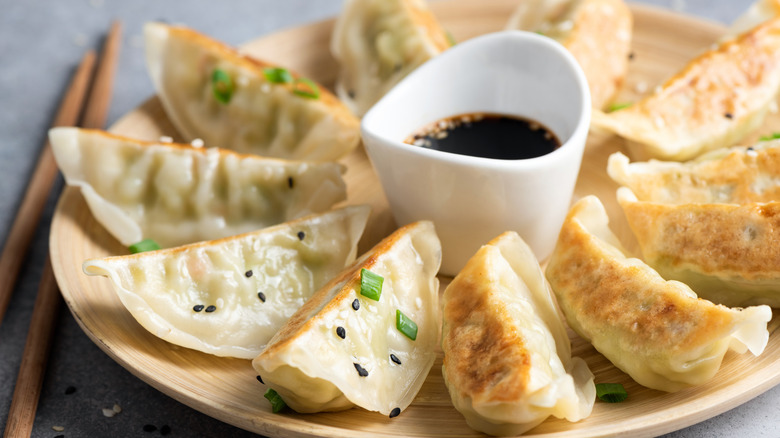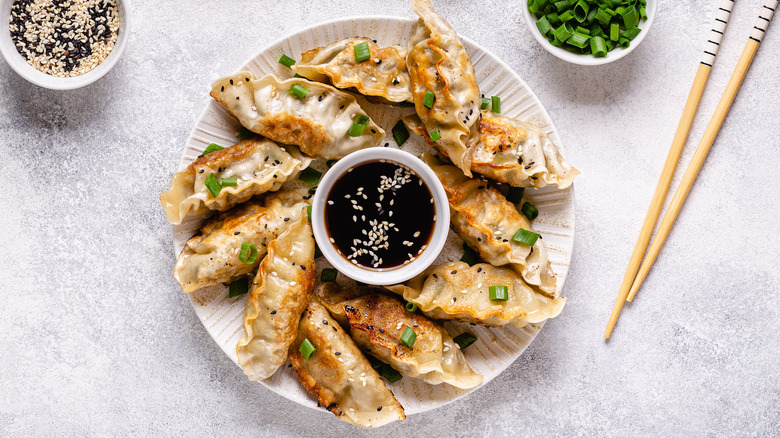Gyoza, Potstickers, And Dumplings: What's The Difference?
There are so many words out there for chopped-up meat or veggies wrapped in dough. In East Asian cuisines alone, you might find gyoza, potstickers, and dumplings written on boxes in Costco's mysterious freezer aisle or in titles on recipe blogs. But how do you know which one you want?
In English, "dumpling" is a catch-all term that covers any kind of filling encased in dough or dough cooked by boiling or steaming. The word could apply to all sorts of doughs, from rice to wheat and beyond, and it doesn't imply a specific filling, although meat, seafood, fruits, or vegetables are probably the most common. Dumplings exist in a lot of cuisines. There are differences between Polish pierogi and Italian ravioli, but both are technically a dumpling, as are Nepalese momo and even the little masses of tender dough you find in soups in the Southern United States.
Gyoza and potstickers, specifically, can be challenging to identify because they look similar and overlap when it comes to fillings. But despite having a shared history, they're not the same.
What are potstickers?
"Potstickers" is the English word for a popular preparation of a common Chinese dumpling. Their original Chinese name is "jiaozi." Potstickers are usually considered to be the crisp-fried version of the dumplings, while the term jiaozi refers to the dumplings more generally, regardless of cooking method (jiaozi can be fried, boiled, or steamed). They've been around for nearly 2,000 years, originating in northern China. They're sometimes considered the original dumplings from which many other cultures developed their own versions, although the history is rather hazy, and it's possible other cultures developed their own dumplings independently.
Potsticker dough is made with wheat flour, and the casing tends to be thicker than gyoza, especially when you're dealing with dumplings in northern China. While you can make the dough yourself, you can also buy it at Chinese grocery stores. They're fairly small — just two or three bites.
Potsticker fillings are savory and vary. Ground meats (like pork, chicken, or shrimp) are very common, often featuring flavors like garlic, scallions, ginger, soy sauce, and cabbage. Vegetarian versions can have fillings like mushrooms, cabbage, or tofu. The cooking process is more complex than that of boiled jiaozi: You fry the dumplings in a skillet, add some water so they steam for a few minutes, then fry one side again until crispy. They are often served with dipping sauces: A mix of vinegar and soy sauce is a classic, but you can add additional flavors, like garlic or chili oil.
What are gyoza?
Gyoza are Japan's favorite dumplings, but they're also descendants of Chinese jiaozi and potstickers: While some say they were a product of Japan's World War II invasion of China, they probably found their way across the East China Sea earlier but became more popular after the war. They're a similar crescent shape to potstickers and tend to be sealed with pleats on top as well. That said, they're usually a little smaller, one to two bites.
Gyoza wrappers are similar in that they're made with wheat flour and water, but they are usually thinner, especially if you use the store-bought versions (it can be tough to get homemade wrappers to the same level of thinness). As with potstickers, the fillings vary, but there's a classic gyoza filling that comes up in a lot of recipes: cabbage, garlic, ginger, scallions, and ground meat (often pork, but sometimes other options, like chicken), and seasonings like sesame oil and soy sauce. Some cooks say that gyoza fillings are often more finely chopped, although this naturally varies depending on who prepares them.
As for the cooking, gyoza can be boiled, steamed, or pan-fried, but pan-fried is the most common version, and people sometimes use the same fry-steam-fry method as potstickers. The dipping sauce can also be a similar soy-vinegar combination to the one that comes with potstickers or jiaozi, although you may also encounter an ingredient known as ponzu, which is different from soy sauce.


